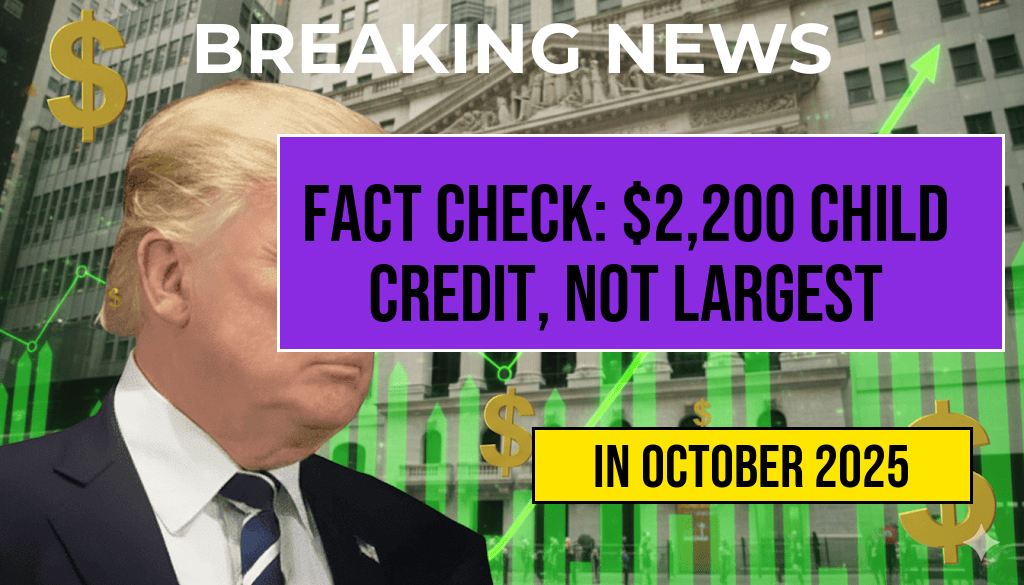Recent social media claims have circulated suggesting that parents are receiving substantial financial boosts, such as a $2,200 child tax credit and a $25,000 tip break, as part of government aid programs or economic relief initiatives. While these figures have sparked excitement and skepticism alike, experts clarify that although such payments are real, they are not unprecedented in their scale. The current child tax credit, introduced through recent legislative updates, offers eligible families up to $2,000 per qualifying child annually, with some temporary enhancements during pandemic relief efforts. The reported $25,000 tip break appears to be a misinterpretation or exaggeration of a specific scenario involving large gratuities, often associated with high-profile events or exceptional circumstances. This article examines the origins of these claims, compares them with historical aid measures, and clarifies what Americans can expect from current programs.
Understanding the Child Tax Credit and Its Limits
The Child Tax Credit (CTC) has been a significant component of U.S. family support policies for decades. Originally established to assist low- and middle-income families, recent legislative changes have expanded its scope. The American Rescue Plan Act of 2021 temporarily increased the maximum credit to $3,600 per child under age 6 and $3,000 for children aged 6 to 17 for 2021, with monthly advance payments. These enhancements were designed as one-time measures to provide relief during the COVID-19 pandemic and have since prompted widespread attention.
For 2023, the standard child tax credit reverted to previous limits, offering up to $2,000 per qualifying child, with eligibility based on income thresholds. The IRS states that the credit is primarily aimed at supporting families with children, but the notion of receiving a $2,200 payment per child as a regular benefit is a misinterpretation of these temporary enhancements or ongoing tax credits.
Historical Context of Large Aid Payments
| Program | Year | Maximum Benefit/Payment | Purpose |
|---|---|---|---|
| American Rescue Plan Child Tax Credit | 2021 | $3,600 (under age 6) | COVID-19 relief for families |
| Economic Stimulus Payments | 2020–2021 | $1,200–$2,000 per adult; additional per child | COVID-19 economic assistance |
| Tax Refunds and Credits | Various years | Varies, up to several thousand dollars | Tax relief and incentives |
These programs have historically provided significant financial support, but none have included a permanent or guaranteed $25,000 tip break. Large gratuities, such as those seen in high-end hospitality or celebrity events, are exceptional and not part of federal aid schemes.
The Myth of the $25,000 Tip Break
Claims about a $25,000 tip bonus often stem from a misunderstanding or misreporting of large gratuities given at exclusive events or as promotional gestures. Some viral posts refer to instances where wealthy individuals or celebrities have left substantial tips, but these are isolated incidents rather than a widespread or government-backed benefit. The U.S. Department of Labor’s data shows that typical restaurant tips average around $20–$30 per hour, with top earners occasionally tipping hundreds or thousands, but not in the tens of thousands regularly.
It is also crucial to distinguish between tips and government benefits. While large gratuities can significantly boost a worker’s income, they are not part of federal aid programs like the child tax credit or stimulus checks.
Clarifying Expectations for American Families
For families relying on the child tax credit, the key takeaway is that the program provides meaningful assistance but within defined limits. The maximum benefit for 2023 remains at $2,000 per child, with eligibility phased out for higher-income households. The temporary enhancements from the pandemic era are no longer active, but ongoing legislation may adjust these figures in the future.
There are no current federal programs that guarantee or distribute a $25,000 bonus in the form of tips or aid. Instead, families should focus on understanding their eligibility for existing credits and benefits, which are designed to support economic stability.
For more information on the child tax credit and related aid programs, consult official resources like the IRS website (https://www.irs.gov/credits-deductions/child-tax-credit) or the U.S. Department of Education.
Frequently Asked Questions
Question
What is the main focus of the article regarding the $2,200 Child Credit and $25,000 Tip Break?
Question
Are the $2,200 Child Credit and $25,000 Tip Break legitimate benefits or offers?
Question
Does the article confirm that these benefits are the largest ever in their respective categories?
Question
What should consumers know about the fact-checking process related to these claims?
Question
Are there any important caveats or limitations associated with these benefits that readers should be aware of?






